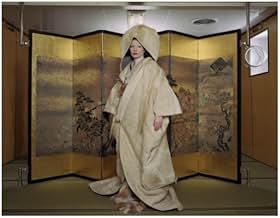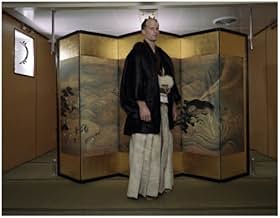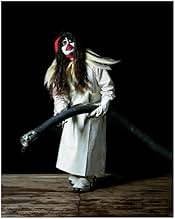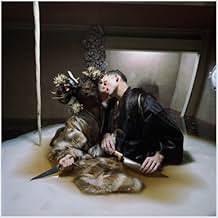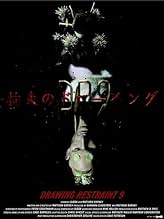AVALIAÇÃO DA IMDb
6,5/10
1,6 mil
SUA AVALIAÇÃO
Adicionar um enredo no seu idiomaThe film concerns the theme of self-imposed limitation and continues Matthew Barney's interest in religious rite, this time focusing on Shinto.The film concerns the theme of self-imposed limitation and continues Matthew Barney's interest in religious rite, this time focusing on Shinto.The film concerns the theme of self-imposed limitation and continues Matthew Barney's interest in religious rite, this time focusing on Shinto.
- Prêmios
- 1 indicação no total
Avaliações em destaque
There's no dialogue for a while, and then there's some Japanese dialogue, and all the while, I didn't really know what was going on. I was lost at pretty much all times, but that was to be expected. This had "avant-garde" written all over it, and for being an art piece, I guess it's sporadically interesting. It probably achieves what it sets out to do, but whatever that is feels unclear to me. If you want to dive in, there's probably a lot to chew on, but as to whether it would taste any good, who knows. Probably not. But it's challenging. That's more of an observation rather than something that makes it bad or good. And there's some music here composed by Bjork, though she didn't do all the music it seems. I don't know.
That's my take away. I don't know.
That's my take away. I don't know.
It you are Japanese or know something about Japanese mythology and/or whaling culture in japan, then this movie will mean a lot more to you than others.
I know most people who watch this movie will come out of the theater ferociously hating Matthew Barney and be turned off of modern art, but for me, this movie was grounded in ancient Japanese traditions. And to have witnessed it, even if it is bastardized from it's Japanese roots, is a fortunate event.
I'll attempt to write the plot as I saw it.
Barney and Bjork were invited onto the whaling vessel as guests. They begin their journey by transforming into sea spirits through several elaborate and beautiful (however long and confusing) ceremonies and rites of passages . This all happens while the whaling crew perform their duties on the symbolic whale. In the end the journey takes a gruesome turn and the transformation is complete.
This is by no means an easy movie to sit through, be forewarned. However, I believe the value is in your furthered exploration into the subject of Japanese culture, ritual and mythology.
Be sure to check out the exhibit at your local museum if it comes to your town. It is absolutely amazing to see.
I know most people who watch this movie will come out of the theater ferociously hating Matthew Barney and be turned off of modern art, but for me, this movie was grounded in ancient Japanese traditions. And to have witnessed it, even if it is bastardized from it's Japanese roots, is a fortunate event.
I'll attempt to write the plot as I saw it.
Barney and Bjork were invited onto the whaling vessel as guests. They begin their journey by transforming into sea spirits through several elaborate and beautiful (however long and confusing) ceremonies and rites of passages . This all happens while the whaling crew perform their duties on the symbolic whale. In the end the journey takes a gruesome turn and the transformation is complete.
This is by no means an easy movie to sit through, be forewarned. However, I believe the value is in your furthered exploration into the subject of Japanese culture, ritual and mythology.
Be sure to check out the exhibit at your local museum if it comes to your town. It is absolutely amazing to see.
I just saw this the other day. I Was in the second row of the cinema so close to all these weird happenings. I knew that it would be slow and hardly without a story. With that in mind I really liked the slow moving pictures, the building of the big Vaseline-sculpture, and the meeting between Björk and Barney(it takes a long time before they actually meet on screen)
I see why some people would find it annoying, but to me it had some stunning visuals and the music was really good.
Just sit back and relax and don't expect much more than two hours of slow moving and weird stuff.
I see why some people would find it annoying, but to me it had some stunning visuals and the music was really good.
Just sit back and relax and don't expect much more than two hours of slow moving and weird stuff.
To hear Matthew Barney interviewed, saying things like "I will continue to manipulate space in film," you would think that he has nothing on his mind but process. Yet the evolution of Drawing Restraint 9 is spiritual, not formal. DR9, in fact, is a complete repudiation of the noxious Ayn Rand-stinking cosmology of the Cremaster films. Freud has been replaced by Jung, and Hegel by Kierkegaard. This is a Barney film that could bring you to tears. Any doubts about whether he's an artist or fraud are laid to rest by this film -- frauds do not grow, they just keep along the same path.
I had my doubts about the Cremaster films ( except for Cremaster 2, still the most uncanny piece on Barney's resume ) The first hour and a half of Drawing Restraint 9 had me squirming, sure that Barney was unmasking himself as a joke once and for all. All of Barney's faults are on display -- the crude appropriation and dim understanding of other cultures and myths, the glossy yet flat cinematography that would only look stylish to a reader of Vogue, the hunch that the only movie he's ever seen is The Shining, and a generally unfocused feeling, as if he's casting around for meaning that isn't there. And then, of course, there are those endless shots of men doing their work, building a better future, creating that obelisk to the sky! Except here the bumbleheaded Hegelian philosophy of history-in-action was even more boring because of the documentary trappings. Instead of showing a legless woman strap on a blade and chop potatoes, a metaphor for a half-completed action, we see real men doing real jobs. Only occasionally Barney has them producing one of his symbols, or sticks a blue feathered afro on top of a tanker, so that we know these seemingly mundane tasks will eventually have vaguely triumphant, Wagnerian results.
Then, suddenly -- if you can speak of suddenness in a film like this, and I think you can -- the Japanese men start loading a harpoon gun and firing nasty spikes at nasty speeds into the sea. And you realize that what you took to be another Barney paean to progress has crumbled. We are now sailing in deep hippie waters, my friend. And the sailing is good. Barney and Bjork retire to a tatami-matted cabin and the film begins to go places the Cremaster films would never dare. The cinematographer suddenly discovers shadow and grain-texture. Bjork's uninspired score becomes hypnotic. A feeling of death, doubt, and failure creeps into the film, as a Japanese sage tells a story of a primal scar made by the collision of two ships, while Barney and Bjork are posed with the edge of a whale statue separating them. The personal, the political, the spiritual and the mythical start to engage in supercollision.
The film seems to have been conceived as an exercise in humility, repentance for the colossal egotism of the Cremaster films. Barney takes pains to highlight his new bald spot, making him look like a tonsured monk, there is a nude scene which proves he is no Vincent Gallo, and -- most memorably -- Barney speaks! As a studly silent mannequin in the Cremaster films, he had mystery, but here he lets you in on the dirty little secret: He has the geekiest voice in history, almost like how a castrato would talk in daily conversation. Listen closer, however, and he sounds almost angelic...
This new humility, which may have roots in marriage troubles or encroaching baldness -- the root of insight is often just this shallow -- justifies the Asiatic trappings. But Barney is hiding his real light under a bushel. It is a Western religion that truly moves him these days. There are a "trinity" ( hint hint ) of symbols consisting of whale ambergris, pomegranate seeds and shrimp whose meaning I won't spoil for you. Except to say that Barney is calling you a shrimp. And asking you to be a whale. The "restraint" of the title starts to feel a whole lot more like renunciation, and the inner joys it brings.
Life is fair after all: It costs ten dollars for a ticket to DR9, and unless you're a zombie, you will get more pleasure and consolation from this film than any billionaire computer-peddler could get out of one of Barney's vaseline tubs.
I had my doubts about the Cremaster films ( except for Cremaster 2, still the most uncanny piece on Barney's resume ) The first hour and a half of Drawing Restraint 9 had me squirming, sure that Barney was unmasking himself as a joke once and for all. All of Barney's faults are on display -- the crude appropriation and dim understanding of other cultures and myths, the glossy yet flat cinematography that would only look stylish to a reader of Vogue, the hunch that the only movie he's ever seen is The Shining, and a generally unfocused feeling, as if he's casting around for meaning that isn't there. And then, of course, there are those endless shots of men doing their work, building a better future, creating that obelisk to the sky! Except here the bumbleheaded Hegelian philosophy of history-in-action was even more boring because of the documentary trappings. Instead of showing a legless woman strap on a blade and chop potatoes, a metaphor for a half-completed action, we see real men doing real jobs. Only occasionally Barney has them producing one of his symbols, or sticks a blue feathered afro on top of a tanker, so that we know these seemingly mundane tasks will eventually have vaguely triumphant, Wagnerian results.
Then, suddenly -- if you can speak of suddenness in a film like this, and I think you can -- the Japanese men start loading a harpoon gun and firing nasty spikes at nasty speeds into the sea. And you realize that what you took to be another Barney paean to progress has crumbled. We are now sailing in deep hippie waters, my friend. And the sailing is good. Barney and Bjork retire to a tatami-matted cabin and the film begins to go places the Cremaster films would never dare. The cinematographer suddenly discovers shadow and grain-texture. Bjork's uninspired score becomes hypnotic. A feeling of death, doubt, and failure creeps into the film, as a Japanese sage tells a story of a primal scar made by the collision of two ships, while Barney and Bjork are posed with the edge of a whale statue separating them. The personal, the political, the spiritual and the mythical start to engage in supercollision.
The film seems to have been conceived as an exercise in humility, repentance for the colossal egotism of the Cremaster films. Barney takes pains to highlight his new bald spot, making him look like a tonsured monk, there is a nude scene which proves he is no Vincent Gallo, and -- most memorably -- Barney speaks! As a studly silent mannequin in the Cremaster films, he had mystery, but here he lets you in on the dirty little secret: He has the geekiest voice in history, almost like how a castrato would talk in daily conversation. Listen closer, however, and he sounds almost angelic...
This new humility, which may have roots in marriage troubles or encroaching baldness -- the root of insight is often just this shallow -- justifies the Asiatic trappings. But Barney is hiding his real light under a bushel. It is a Western religion that truly moves him these days. There are a "trinity" ( hint hint ) of symbols consisting of whale ambergris, pomegranate seeds and shrimp whose meaning I won't spoil for you. Except to say that Barney is calling you a shrimp. And asking you to be a whale. The "restraint" of the title starts to feel a whole lot more like renunciation, and the inner joys it brings.
Life is fair after all: It costs ten dollars for a ticket to DR9, and unless you're a zombie, you will get more pleasure and consolation from this film than any billionaire computer-peddler could get out of one of Barney's vaseline tubs.
DR9 shouldn't really be thought of as a film in the traditional sense of the word, nor should it sit alone, its part of a greater work of art, the clue is in the title! To really appreciate the film it helps to see it in relation to sculpture and the way objects interact within a chosen space. also the resonance of ritual and especially Japanese shinto can bring a certain amount of meaning and clarity to some of the more obscure sequences in the film. even though it seems very 'serious and arty' on the surface ,there is humour and romance and the film! try not to see it as a finite static thing, but something that can change according to the multiple layers you allow yourself to perceive it on.
Você sabia?
- Trilhas sonorasGratitude
Written by Björk and Matthew Barney
Vocal by Will Oldham
Harp played by Zeena Parkins
Celeste played by Jónas Sen
Keyboard played by Nico Muhly
Arranging & editing by Björk
Programming by Björk and Valgeir Sigurðsson
Produced by Björk
Principais escolhas
Faça login para avaliar e ver a lista de recomendações personalizadas
- How long is Drawing Restraint 9?Fornecido pela Alexa
Detalhes
- Data de lançamento
- Países de origem
- Central de atendimento oficial
- Idiomas
- Também conhecido como
- Растворение мира
- Locações de filme
- Empresa de produção
- Consulte mais créditos da empresa na IMDbPro
Bilheteria
- Faturamento bruto nos EUA e Canadá
- US$ 234.743
- Fim de semana de estreia nos EUA e Canadá
- US$ 18.011
- 2 de abr. de 2006
- Faturamento bruto mundial
- US$ 267.275
- Tempo de duração2 horas 15 minutos
- Cor
- Mixagem de som
- Proporção
- 1.85 : 1
Contribua para esta página
Sugerir uma alteração ou adicionar conteúdo ausente

Principal brecha
By what name was Drawing Restraint 9 (2005) officially released in Canada in English?
Responda

